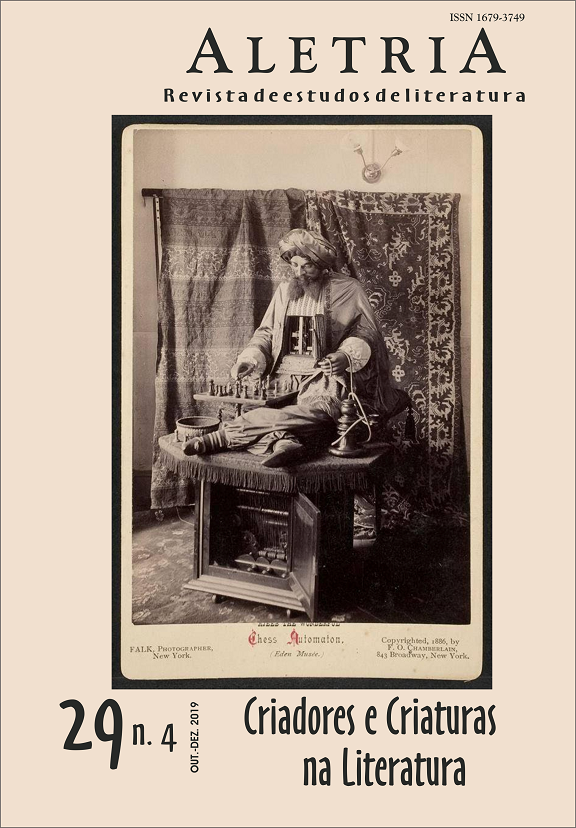“Querido leitor, depende de você”: uma leitura de Sweet Tooth, de Ian McEwan, de acordo com a teoria do efeito estético e a metaficção
DOI:
https://doi.org/10.17851/2317-2096.29.4.141-164Palavras-chave:
teoria do efeito estético, leitor implícito, metaficção; paródia, mise en abyme, Ian McEwan, Sweet ToothResumo
Neste artigo, objetivamos discutir a figura do leitor e os processos de leitura no romance Sweet Tooth, de Ian McEwan. Para tanto, propomos uma articulação entre os discursos teóricos sobre metaficção e a teoria do efeito estético. Baseando-nos especialmente em estudos de Iser (1972, 1978, 1989, 2006) – em relação à teoria do efeito estético – e de Hutcheon (1980, 2000) e Waugh (1984) – referentes à metaficção – compreendemos paródia e mise en abyme como duas estratégias metaficcionais que constituem a estrutura do leitor implícito. Nesse sentido, se tais estratégias tornam a leitura do romance mais complexa, elas também funcionam como guias para o leitor, permitindo que ele persiga respostas para os enigmas instituídos na narrativa. Paródia e mise en abyme, para McEwan, são ferramentas robustas no que percebemos como um projeto para desenvolver leitores mais proficientes.
Downloads
Referências
DÄLLENBACH, Lucien. El relato especulado. Translated by Ramón Buenaventura. Madrid: Visor, 1991.
DOBIE, Ann B. Theory into Practice: An Introduction to Literary criticism. 3. ed. Boston: Wadsworth, 2012.
HOLUB, Robert C. Constance School of Reception Aesthetics [Reception Theory]. In: MAKARYK, Irena R. (org.). Encyclopedia of Contemporary Literary Theory: Approaches, Scholars, Terms. Toronto: University of Toronto Press, 1993. p. 14 -18. DOI: https://doi.org/10.3138/9781442674417-006.
HUTCHEON, Linda. A Theory of Parody: The Teachings of Twentieth-Century Art Forms. Urbana; Chicago: University of Illinois Press, 2000.
HUTCHEON, Linda. Narcissistic Narrative: The Metafictional Paradox. Waterloo: Wilfrid Laurier University Press, 1980.
ISER, Wolfgang. How to Do Theory. Oxford: Blackwell, 2006.
ISER, Wolfgang. Prospecting: From Reader Response to Literary Anthropology. Baltimore: John Hopkins University Press, 1989.
ISER, Wolfgang. The Act of Reading: A Theory of Aesthetic Response. Baltimore: John Hopkins University Press, 1978.
ISER, Wolfgang. The Reading Process: A Phenomenological Approach. New Literary History, Baltimore, MD, v. 3, n. 2, p. 279-299, 1972. DOI: https://doi.org/10.2307/468316.
KORKUT, Nil. Kinds of Parody: From the Medieval to the Postmodern. 2005. 185 f. Thesis (Doctorate of Philosophy in English Literature) – Graduate School of Social Sciences, Middle East Technical University, Ankara, 2005.
LODGE, David. The Art of Fiction. New York: Viking, 1993.
MARCUS, Laura. Detection and Literary Fiction. In: PRIESTMAN, Martin (org.). The Cambridge Companion to Crime Fiction. Cambridge: Cambridge University Press, 2003, p. 245-267.
McEWAN, Ian. Sweet Tooth. London: Vintage, 2013.
McEWAN. Ian. The Guardian – Interview Ian McEwan – Sweet Tooth. [Interview conceded to] John Mullan. [S. l: s. n.], 2015. 1 video. (36:22 min). Published by channel Oswaldo Armendariz. Available at: https://www.youtube.com/watch?v=b53AyL87gLk. Retrieved on: 30 May 2017.
MERIVALE, Patricia. Postmodern and Metaphysical Detection. In: RZEPKA, Charles; HORSLEY, Lee (org.). A Companion to Crime Fiction. Malden: Wiley-Blackwell, 2010. p. 308-320. DOI: https://doi.org/10.1002/9781444317916.ch24.
NEUMANN, Birgit; NÜNNING, Ansgar. Metanarration and Metafiction. 2014. Available at: http://www.lhn.uni-hamburg.de/article/metanarration-and-metafiction. Retrieved on: 10 Aug. 2019.
PIGLIA, Ricardo. O último leitor. Tradução de Heloisa Jahn. São Paulo: Companhia das Letras, 2006.
RITA, Annabela. Mise en abyme. In: CEIA, Carlos (org.). E-dicionário de termos literários. 2010. Available at: http://edtl.fcsh.unl.pt/encyclopedia/mise-en-abyme/. Retrieved on: 13 Aug. 2019.
RON, Moshe. The Restricted Abyss: Nine Problems in the Theory of mise en abyme. Poetics Today, Duhan, NC, v. 8, n. 2, p. 417-438, 1987. DOI: https://doi.org/10.2307/1773044.
WAUGH, Patricia. Metafiction: The Theory and Practice of Self-Conscious Fiction. London; New York: Routledge, 1984. DOI: https://doi.org/10.2307/1771928.
Downloads
Publicado
Como Citar
Edição
Seção
Licença
Copyright (c) 2019 Caio Antônio Nóbrega, Genilda Azerêdo (Autor)

Este trabalho está licenciado sob uma licença Creative Commons Attribution 4.0 International License.
Autores que publicam nesta revista concordam com os seguintes termos:Autores mantém os direitos autorais e concedem à revista o direito de primeira publicação, com o trabalho simultaneamente licenciado sob a Licença Creative Commons Attribution que permite o compartilhamento do trabalho com reconhecimento da autoria e publicação inicial nesta revista.Autores têm autorização para assumir contratos adicionais separadamente, para distribuição não-exclusiva da versão do trabalho publicada nesta revista (ex.: publicar em repositório institucional ou como capítulo de livro), com reconhecimento de autoria e publicação inicial nesta revista.Autores têm permissão e são estimulados a publicar e distribuir seu trabalho online (ex.: em repositórios institucionais ou na sua página pessoal) a qualquer ponto antes ou durante o processo editorial, já que isso pode gerar alterações produtivas, bem como aumentar o impacto e a citação do trabalho publicado (Veja The Effect of Open Access).





